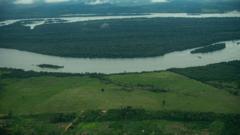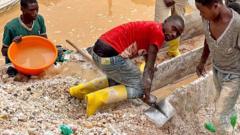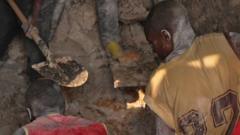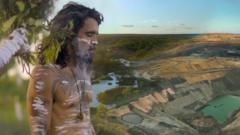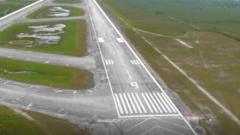Stary Mwaba's artwork poignantly depicts the dangers faced by young miners and reflects on the intertwined narratives of community and hardship amidst environmental degradation.
**Exploring Zambia's Toxic Mining Legacy Through Art**
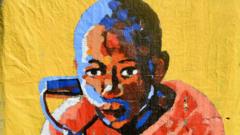
**Exploring Zambia's Toxic Mining Legacy Through Art**
An artist sheds light on the hazardous history of Zambia's Copperbelt and its impact on local communities.
In the heart of Zambia, the "black mountains"—giant heaps of mining waste—loom over the Copperbelt region, serving as both a symbol of industrial legacy and a source of livelihood for many. Renowned visual artist Stary Mwaba, rooted in the area, has taken inspiration from these toxic landscapes to highlight the struggles of local youth. “As children, we called it 'mu danger,' a place where we should not go,” Mwaba recalls. Despite the dangers posed by mining waste, young men scour these mountains for copper ore, often under perilous, illegal conditions to meet their economic needs in a region plagued by a 45% youth unemployment rate.
Currently exhibited at the Lusaka National Museum, Mwaba's latest project intricately captures the essence of the Wusakile neighborhood in Kitwe. Through a series of portraits painted on repurposed newspaper canvases, Mwaba combines personal stories with broader societal issues. He meticulously cuts out elements from the articles, symbolizing how individual narratives often get lost in the grander storytelling of the nation’s mining history. “I create holes so that you can't make sense of the stories anymore,” he explains, emphasizing how the lives of ordinary people are essential components in the broader context of Zambia’s mining industry.
The environmental impacts of the mining industry are devastating. Toxic heavy metals from mining waste have not only rendered the earth perilous but also compromised the health of local residents. A painting titled *Jerabo* exemplifies the hazardous reality faced by many miners, as it depicts one preparing his safety gear for descending treacherous tunnels. Mwaba's transformation from personal reflections to urgent commentaries on community issues originates from a formative experience connected to his daughter’s school project on plant absorption in 2011. Discovering the discomfort surrounding discussions about foreign mining interests fueled his artistic journey towards addressing these pressing topics.
From past influences to current tragedies, Mwaba’s works, including images portraying communal activities and childhood joys, shine a light on the resilience of those living next to the black mountains. For instance, *Shofolo*, reflecting on a young miner’s attachment to their shovel, and *Ipenga*, featuring a musician entertaining locals, reveal how culture and artistry continue to thrive amid adversity.
While Mwaba's artistic approach has received international accolades, his return to his roots serves as a poignant reminder of the changes that have transpired over decades, including the struggles introduced by the 1990s mining privatization. Additionally, Mwaba highlights the exploitation often faced by young miners through the portrait *Boss for a Day*, visualizing the hopes and frustrations of workers grappling with limited opportunities and oppressive hierarchy in the mining industry.
Through activism and art, Mwaba's work fosters a greater understanding of the challenges confronting Zambia’s youth and the need for advocacy in addressing systemic issues within the mining sector. His efforts resonate with those seeking change and provide a fresh perspective on the complex interplay between community, culture, and environment in Zambia's ever-evolving landscape.
Currently exhibited at the Lusaka National Museum, Mwaba's latest project intricately captures the essence of the Wusakile neighborhood in Kitwe. Through a series of portraits painted on repurposed newspaper canvases, Mwaba combines personal stories with broader societal issues. He meticulously cuts out elements from the articles, symbolizing how individual narratives often get lost in the grander storytelling of the nation’s mining history. “I create holes so that you can't make sense of the stories anymore,” he explains, emphasizing how the lives of ordinary people are essential components in the broader context of Zambia’s mining industry.
The environmental impacts of the mining industry are devastating. Toxic heavy metals from mining waste have not only rendered the earth perilous but also compromised the health of local residents. A painting titled *Jerabo* exemplifies the hazardous reality faced by many miners, as it depicts one preparing his safety gear for descending treacherous tunnels. Mwaba's transformation from personal reflections to urgent commentaries on community issues originates from a formative experience connected to his daughter’s school project on plant absorption in 2011. Discovering the discomfort surrounding discussions about foreign mining interests fueled his artistic journey towards addressing these pressing topics.
From past influences to current tragedies, Mwaba’s works, including images portraying communal activities and childhood joys, shine a light on the resilience of those living next to the black mountains. For instance, *Shofolo*, reflecting on a young miner’s attachment to their shovel, and *Ipenga*, featuring a musician entertaining locals, reveal how culture and artistry continue to thrive amid adversity.
While Mwaba's artistic approach has received international accolades, his return to his roots serves as a poignant reminder of the changes that have transpired over decades, including the struggles introduced by the 1990s mining privatization. Additionally, Mwaba highlights the exploitation often faced by young miners through the portrait *Boss for a Day*, visualizing the hopes and frustrations of workers grappling with limited opportunities and oppressive hierarchy in the mining industry.
Through activism and art, Mwaba's work fosters a greater understanding of the challenges confronting Zambia’s youth and the need for advocacy in addressing systemic issues within the mining sector. His efforts resonate with those seeking change and provide a fresh perspective on the complex interplay between community, culture, and environment in Zambia's ever-evolving landscape.

